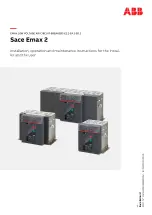
34
Operations-Ground Fault Sensing Schemes
Ground Fault Sensing Scheme
The following are brief descriptions of the ground fault
sensing schemes as they relate to the Siemens Electronic
Trip Unit. Detailed technical and application information of the
ground fault sensing schemes is contained in NEMA Stan-
dard No. PB 2.2 “Application Guide for Ground Fault Protec-
tive Devices for Equipment”.
Residual (3-Phase, 3-Wire). Under normal system conditions
(without ground fault), the vector sum of the phase currents
being monitored by the trip unit is zero. This is also true under
the condition of an overcurrent phase-to-phase fault and
phase-unbalance condition. When a phase-to-ground fault
occurs, the vector sum of the phase currents is directly
proportional to the magnitude of the fault. The trip unit’s
microprocessor uses this vector sum data in the execution of
the ground fault protection function. The trip unit utilizes the
internal breaker current transformers. No external current
transformers are required.
Residual (3-Phase, 4-Wire). In the 3-Phase, 4-Wire Residual
scheme a fourth current transformer is connected in the
neutral conductor to “Sense” normal neutral currents. Under
normal system conditions the vector sum of the currents in all
phases equals the neutral current. This is also true under the
condition of an overcurrent phase-to-phase fault and phase-
unbalance condition. When a phase-to-ground fault occurs,
the fault current returns viaa path other than the neutral.
Therefore, the vector sum of the phase currents no longer
equals the neutral current. This current differential is detected
by the trip unit and used in the execution of the ground fault
protection function.
Source Ground. In this scheme, the phase currents are not
used in detecting and processing ground faults. The trip unit
executes the ground fault protection function based on data
from a ground current sensor. This sensor is located on the
neutral connection to ground at the service entrance, and is
connected to the neutral transformer input terminals on the
trip unit.
Zero Sequence. This scheme is very similar to the Residual
Schemes. A core balance type current sensor encircles all
phase conductors and neutral on a 4-wire system. Under
normal system conditions or a phase-to-phase fault condi-
tion, there is no output from the sensor to the trip unit because
the vector sum of the currents through the sensor window is
zero. If a ground fault occurs, the ground current is not seen
by the sensor, which returns to the source by a path other
than through the sensor window. The sensor detects this
current unbalance and provides the data required by the trip
unit to execute the ground fault protection function. The zero
sequence sensor is connected to the neutral transformer
input on the trip unit.
NOTE: For Neutral Sensor installation, see pages 64-
65. Source Ground Current.
Residual Sensing, Circuit Breaker Wiring for Ground Protec-
tion (3-Phase, 4-Wire System Shown).
Source Ground Current.
Zero Sequence Ground Fault Protection.
Summary of Contents for SBA 1200
Page 68: ...66 External Accessories Ground Fault Sensing and Relaying Courtesy of NationalSwitchgear com ...
Page 94: ...92 Outline Dimension Drawing 2000A Fixed Mounted Courtesy of NationalSwitchgear com ...
Page 95: ...93 Outline Dimension Drawing 2000A Fixed Mounted Courtesy of NationalSwitchgear com ...
Page 100: ...98 Courtesy of NationalSwitchgear com ...
Page 101: ...Electrical Diagrams 99 Courtesy of NationalSwitchgear com ...
Page 102: ...100 Electrical Diagrams Courtesy of NationalSwitchgear com ...




































